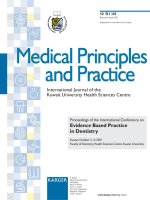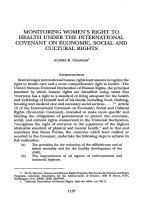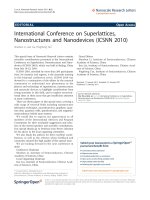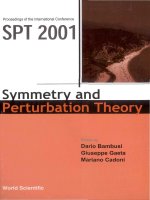Informatics in control automation and robotics selected papers from the international conference on informatics in control automation and robotics 2006 (lecture notes in electrical engineerin TQL)
Bạn đang xem bản rút gọn của tài liệu. Xem và tải ngay bản đầy đủ của tài liệu tại đây (12.45 MB, 374 trang )
Lecture Notes Electrical Engineering
Volume 15
Juan Andrade Cetto · Jean-Louis Ferrier ·
Jos´e Miguel Costa dias Pereira ·
Joaquim Filipe (Eds.)
Informatics in Control
Automation and Robotics
Selected Papers from the International
Conference on Informatics in Control
Automation and Robotics 2006
123
Juan Andrade Cetto
Ramon y Cajal Postdoctoral Fellow
Institut de Robotica i Informatica
Industrial, CSIC-UPC
Llorens Artigas, 4-6
08028 Barcelona
Spain
Professeur Jean-Louis Ferrier
LISA - ISTIA
62, avenue Notre Dame du Lac
49000 Angers
France
Jos´e Miguel Costa Dias Pereira
Instituto Polit´ecnico de Set´ubal
Largo Defensores da Rep´ublica, 1
2910-470 Set´ubal
Portugal
Joaquim Filipe
INSTICC
Av. D. Manuel I
27A 2o Esq.
2910-595 Set´ubal
Portugal
ISBN: 978-3-540-79141-6
e-ISBN: 978-3-540-79142-3
Library of Congress Control Number: 2008926385
c 2008 Springer-Verlag Berlin Heidelberg
This work is subject to copyright. All rights are reserved, whether the whole or part of the material is
concerned, specifically the rights of translation, reprinting, reuse of illustrations, recitation, broadcasting,
reproduction on microfilm or in any other way, and storage in data banks. Duplication of this publication
or parts thereof is permitted only under the provisions of the German Copyright Law of September 9,
1965, in its current version, and permission for use must always be obtained from Springer. Violations are
liable to prosecution under the German Copyright Law.
The use of general descriptive names, registered names, trademarks, etc. in this publication does not imply,
even in the absence of a specific statement, that such names are exempt from the relevant protective laws
and regulations and therefore free for general use.
Cover design: eStudio Calamar S.L.
Printed on acid-free paper
9 8 7 6 5 4 3 2 1
springer.com
Preface
The present book includes a set of selected papers from the third “International
Conference on Informatics in Control Automation and Robotics” (ICINCO 2006),
held in Setúbal, Portugal, from 1 to 5 August 2006, sponsored by the Institute for
Systems and Technologies of Information, Control and Communication (INSTICC).
The conference was organized in three simultaneous tracks: “Intelligent Control
Systems and Optimization”, “Robotics and Automation” and “Systems Modeling,
Signal Processing and Control”.
The book is based on the same structure.
Although ICINCO 2006 received 309 paper submissions, from more than 50
different countries in all continents, only 31 where accepted as full papers. From
those, only 23 were selected for inclusion in this book, based on the classifications
provided by the Program Committee. The selected papers also reflect the
interdisciplinary nature of the conference. The diversity of topics is an important
feature of this conference, enabling an overall perception of several important
scientific and technological trends. These high quality standards will be maintained
and reinforced at ICINCO 2007, to be held in Angers, France, and in future editions
of this conference.
Furthermore, ICINCO 2006 included 7 plenary keynote lectures and 1 tutorial,
given by internationally recognized researchers. Their presentations represented an
important contribution to increasing the overall quality of the conference, and are
partially included in the first section of the book. We would like to express our
appreciation to all the invited keynote speakers who took the time to contribute with a
paper to this book, namely, in alphabetical order: Oleg Gusikhin (Ford Research &
Adv. Engineering), Norihiro Hagita (ATR Intelligent Robotics and Communication
Labs), Gerard T. McKee (University of Reading) and William J. O’Connor,
University College Dublin.
On behalf of the conference organizing committee, we would like to thank all
participants. First of all to the authors, whose quality work is the essence of the
conference and to the members of the program committee, who helped us with their
expertise and time.
As we all know, producing a conference requires the effort of many individuals.
We wish to thank all the people from INSTICC, whose work and commitment were
invaluable.
February 2008
Juan A. Cetto
Jean-Louis Ferrier
José Dias Pereira
Joaquim Filipe
Conference Committee
Conference Chair
Joaquim Filipe, Polytechnic Institute of Setúbal / INSTICC, Portugal
Honorary Chair
Hojjat Adeli, The Ohio State University, U.S.A.
Program Co-chairs
Juan Andrade Cetto, Universitat Autònoma de Barcelona, Spain
Jean-Louis Ferrier, University of Angers, France
José Dias Pereira, Polytechnic Institute of Setúbal, Portugal
Organising Committee
Paulo Brito, INSTICC, Portugal
Marina Carvalho, INSTICC, Portugal
Helder Coelhas, INSTICC, Portugal
Bruno Encarnação, INSTICC, Portugal
Vítor Pedrosa, INSTICC, Portugal
Mónica Saramago, INSTICC, Portugal
Programme Committee
Eugenio Aguirre, Spain
Frank Allgower, Germany
Fouad Al-Sunni, Saudi Arabia
Yacine Amirat, France
Luis Antunes, Portugal
Peter Arato, Hungary
Helder Araújo, Portugal
Gustavo Arroyo-Figueroa, Mexico
Marco Antonio Arteaga, Mexico
Nikos Aspragathos, Greece
Miguel Ayala Botto, Portugal
Robert Babuska, The Netherlands
Mark Balas, U.S.A.
Bijnan Bandyopadhyay, India
Ruth Bars, Hungary
Karsten Berns, Germany
Patrick Boucher, France
Guido Bugmann, U.K.
Edmund Burke, U.K.
Kevin Burn, U.K.
Clifford Burrows, U.K.
Luis M. Camarinha-Matos, Portugal
Marco Campi, Italy
Jorge Martins de Carvalho, Portugal
Alicia Casals, Spain
Christos Cassandras, U.S.A.
Raja Chatila, France
Tongwen Chen, Canada
Albert M. K. Cheng, U.S.A.
Sung-Bae Cho, Korea
Ryszard S. Choras, Poland
Carlos Coello Coello, Mexico
António Dourado Correia, Portugal
Yechiel Crispin, U.S.A.
Keshav Dahal, U.K.
Danilo De Rossi, Italy
Angel P. del Pobil, Spain
Guilherme DeSouza, U.S.A.
Rüdiger Dillmann, Germany
Denis Dochain, Belgium
VIII
Conference Committee
Alexandre Dolgui, France
Marco Dorigo, Belgium
Wlodzislaw Duch, Poland
Heinz-Hermann Erbe, Germany
Gerardo Espinosa-Perez, Mexico
Simon Fabri, Malta
Jean-Louis Ferrier, France
Florin Gheorghe Filip, Romania
Manel Frigola, Spain
Colin Fyfe, U.K.
Dragan Gamberger, Croatia
Lazea Gheorghe, Romania
Maria Gini, U.S.A.
Alessandro Giua, Italy
Luis Gomes, Portugal
John Gray, U.K.
Dongbing Gu, U.K.
José J. Guerrero, Spain
Thomas Gustafsson, Sweden
Maki K. Habib, Japan
Hani Hagras, U.K.
Wolfgang Halang, Germany
J. Hallam, Denmark
Riad Hammoud, U.S.A.
Uwe D. Hanebeck, Germany
John Harris, U.S.A.
Dominik Henrich, Germany
Francisco Herrera, Spain
Gábor Horváth, Hungary
Weng Ho, Singapore
Alamgir Hossain, U.K.
Marc Van Hulle, Belgium
Atsushi Imiya, Japan
Sirkka-Liisa Jämsä-Jounela, Finland
Ray Jarvis, Australia
Ivan Kalaykov, Sweden
Nicos Karcanias, U.K.
Fakhri Karray, Canada
Dusko Katic, Serbia & Montenegro
Kazuhiko Kawamura, U.S.A.
Nicolas Kemper, Mexico
Graham Kendall, U.K.
Uwe Kiencke, Germany
Jozef Korbicz, Poland
Israel Koren, U.S.A.
Bart Kosko, U.S.A.
Elias Kosmatopoulos, Greece
George L. Kovács, Hungary
Krzysztof Kozlowski, Poland
Gerhard Kraetzschmar, Germany
Anton Kummert, Germany
Jean-Claude Latombe, U.S.A.
Loo Hay Lee, Singapore
Graham Leedham, Singapore
Kauko Leiviskä, Finland
Zongli Lin, U.S.A.
Cheng-Yuan Liou, Taiwan
Brian Lovell, Australia
Peter Luh, U.S.A.
Anthony Maciejewski, U.S.A.
N. P. Mahalik, Korea
Frederic Maire, Australia
Bruno Maione, Italy
Om Malik, Canada
Jacek Mandziuk, Poland
Philippe Martinet, France
Aleix Martinez, U.S.A.
Rene V. Mayorga, Canada
Gerard McKee, U.K.
Seán McLoone, Ireland
Basil Mertzios, Greece
Shin-ichi Minato, Japan
José Mireles Jr., Mexico
Vladimir Mostyn, Czech Republic
Kenneth Muske, U.S.A.
Ould Khessal Nadir, Canada
Fazel Naghdy, Australia
Sergiu Nedevschi, Romania
Maria Neves, Portugal
Hendrik Nijmeijer, The Netherlands
Urbano Nunes, Portugal
José Valente de Oliveira, Portugal
Andrzej Ordys, U.K.
Djamila Ouelhadj, U.K.
Michel Parent, France
Thomas Parisini, Italy
Gabriella Pasi, Italy
Witold Pedrycz, Canada
Carlos Eduardo Pereira, Brazil
Maria Petrou, U.K.
J. Norberto Pires, Portugal
Marios Polycarpou, Cyprus
Marie-Noëlle Pons, France
Libor Preucil, Czech Republic
Bernardete Ribeiro, Portugal
M. Isabel Ribeiro, Portugal
Conference Committee
Robert Richardson, U.K.
John Ringwood, Ireland
Juha Röning, Finland
Agostinho Rosa, Portugal
Hubert Roth, Germany
António Ruano, Portugal
Erol Sahin, Turkey
Antonio Sala, Spain
Abdel-Badeeh M. Salem, Egypt
Ricardo Sanz, Spain
Medha Sarkar, U.S.A.
Nilanjan Sarkar, U.S.A.
Jurek Sasiadek, Canada
Carlos Sagüés, Spain
Daniel Sbarbaro, Chile
Klaus Schilling, Germany
Chi-Ren Shyu, U.S.A.
Bruno Siciliano, Italy
João Silva Sequeira, Portugal
Mark Spong, U.S.A.
Tarasiewicz Stanislaw, Canada
Aleksandar Stankovic, U.S.A.
Gerrit van Straten, The Netherlands
Raúl Suárez, Spain
Ryszard Tadeusiewicz, Poland
Tianhao Tang, China
Daniel Thalmann, Switzerland
Gui Yun Tian, U.K.
Ivan Tyukin, Japan
Cees van Leeuwen, Japan
Annamaria R. Varkonyi-Koczy,
Hungary
Bernardo Wagner, Germany
Axel Walthelm, Germany
Jun Wang, China
Lipo Wang, Singapore
Alfredo Weitzenfeld, Mexico
Dirk Wollherr, Germany
Sangchul Won, Korea
Kainam Thomas Wong, Canada
Jeremy Wyatt, U.K.
Alex Yakovlev, U.K.
Hujun Yin, U.K.
Anibal Zanini, Argentina
Yanqing Zhang, U.S.A.
Dayong Zhou, U.S.A.
Albert Zomaya, Australia
Detlef Zuehlke, Germany
Auxiliary Reviewers
Alejandra Barrera, Mexico
Levent Bayindir, Turkey
Domingo Biel, Spain
Stephan Brummund, Germany
F. Wilhelm Bruns, Germany
Roman Buil, U.S.A.
Yang Cao, China
Raquel Cesar, Portugal
Ying Chen, U.S.A.
Paulo Coelho, Portugal
Gert van Dijck, Belgium
Liya Ding, U.S.A.
Didier Dumur, France
Adriano Fagiolini, Italy
Daniele Fontanelli, Italy
Jeff Fortuna, U.S.A.
Istvan Harmati, Hungary
Sunghoi Huh, Italy
Feng Jin, China
Abhinaya Joshi, U.S.A.
Balint Kiss, Hungary
Yan Li, China
Gonzalo Lopez-Nicolas, Spain
Patrick De Mazière, Belgium
Rafael Muñoz-Salinas, Spain
Ana Cristina Murillo, Spain
Ming Ni, U.S.A.
Soumen Sen, Italy
Razvan Solea, Portugal
Onur Soysal, Turkey
Wei Tan, China
Giovanni Tonietti, Italy
Ali Emre Turgut, Turkey
Jörg Velten, Germany
Anne von Vietinghoff, Germany
Youqing Wang, China
Yunhua Wang, U.S.A.
Bo Xiong, U.S.A.
Bailly Yan, France
Feng Zhao, U.S.A.
IX
X
Conference Committee
Invited Speakers
Mihaela Ulieru, The University of New Brunswick, Canada
Oleg Gusikhin, Ford Research & Adv. Engineering, U.S.A.
Norihiro Hagita, ATR Intelligent Robotics and Communication Laboratories, Japan
Hojjat Adeli, The Ohio State University, U.S.A.
Mark d'Inverno, University of Westminster, U.K.
William J. O’Connor, University College Dublin, Ireland
Gerard T. McKee, The University of Reading, U.K.
Contents
Invited Papers
Intelligent Vehicle Systems: Applications and New Trends
Oleg Gusikhin, Dimitar Filev and Nestor Rychtyckyj................................................... 3
Symbiosis of Human and Communication Robots
Norihiro Hagita, Hiroshi Ishiguro, Takahiro Miyashita, Takayuki Kanda,
Masahiro Shiomi and Kazuhiro Kuwabara ................................................................ 15
Wave-based Control of Flexible Mechanical Systems
William J. O'Connor................................................................................................... 25
What is Networked Robotics?
Gerard McKee ............................................................................................................ 35
Part I: Intelligent Control Systems and Optimization
Encoding Fuzzy Diagnosis Rules as Optimisation Problems
Antonio Sala, Alicia Esparza, Carlos Ariño and Jose V. Roig ................................... 49
A Multi-agent Home Automation System for Power Management
Shadi Abras, Stéphane Ploix, Sylvie Pesty and Mireille Jacomino ............................ 59
Feature Selection for Identification of Spot Welding Processes
Eija Haapalainen, Perttu Laurinen, Heli Junno, Lauri Tuovinen
and Juha Röning......................................................................................................... 69
Fuzzy Logic Based UAV Allocation and Coordination
James F. Smith III and ThanhVu H. Nguyen .............................................................. 81
Neural Network Model Based on Fuzzy ARTMAP for Forecasting
of Highway Traffic Data
D. Boto-Giralda, M. Antón-Rodríguez, F. J. Díaz-Pernas
and J. F. Díez-Higuera ............................................................................................... 95
Automated Generation of Optimal Controllers through Model
Checking Techniques
Giuseppe Della Penna, Daniele Magazzeni, Alberto Tofani,
Benedetto Intrigila, Igor Melatti and Enrico Tronci ................................................ 107
XII
Contents
Part II: Robotics and Automation
Autonomous Gait Pattern for a Dynamic Biped Walking
Christophe Sabourin, Kurosh Madani and Olivier Bruneau .................................... 123
Particle-filter Approach for Cooperative Localization
in Unstructured Scenarios
Fernando Gomez Bravo, Alberto Vale and Maria Isabel Ribeiro ............................ 141
Interaction Control Experiments for a Robot with one Flexible Link
L. F. Baptista, N. F. S. Bóia, J. M. M. Martins and J. M. G. Sá da Costa................ 155
Smooth Trajectory Planning for Fully Automated Passengers Vehicles:
Spline and Clothoid Based Methods and its Simulation
Larissa Labakhua, Urbano Nunes, Rui Rodrigues and Fátima S. Leite................... 169
Finding the Best Classifier for Evaluating Cork Quality
in an Industrial Environment
Beatriz Paniagua-Paniagua, Miguel A. Vega-Rodríguez,
Juan A. Gómez-Pulido and Juan M. Sánchez-Pérez................................................. 183
Visual Topological Map Building in Self-similar Environments
Toon Goedemé, Tinne Tuytelaars and Luc Van Gool............................................... 195
Image Motion Estimator to Track Trajectories Specified With Respect
to Moving Objects
J. Pomares, G. J. García, L. Payá and F. Torres ..................................................... 207
Depth Gradient Image Based on Silhouette: A Solution for Reconstruction
of Scenes in 3D Environments
Pilar Merchán, Antonio Adán and Santiago Salamanca.......................................... 219
Tracking Multiple Objects using the Viterbi Algorithm
Andreas Kräußling ................................................................................................... 233
Reactive Simulation for Real-Time Obstacle Avoidance
Mariolino De Cecco, Enrico Marcuzzi, Luca Baglivo and Mirco Zaccariotto ........ 249
A Gain-Scheduling Approach for Airship Path-Tracking
Alexandra Moutinho and José Raul Azinheira ......................................................... 263
Semiotics and Human-Robot Interaction
João Silva Sequeira and Maria Isabel Ribeiro......................................................... 277
Contents
XIII
Part III: Signal Processing, Systems Modeling and Control
Multimodelling Steps for Free-Surface Hydraulic System Control
Eric Duviella, Philippe Charbonnaud and Pascale Chiron ..................................... 295
Model-based Reconstruction of Distributed Phenomena using Discretized
Representations of Partial Differential Equations
Felix Sawo, Kathrin Roberts and Uwe D. Hanebeck................................................ 307
GA-based Approach to Pitch Recognition of Musical Consonance
Masanori Natsui, Shunichi Kubo and Yoshiaki Tadokoro........................................ 327
Controlling the Lorenz System with Delay
Yechiel J. Crispin...................................................................................................... 339
Hardware-in-the-Loop Simulations for FPGA-based Digital Control Design
Carlos Paiz, Christopher Pohl and Mario Porrmann .............................................. 355
Author Index ........................................................................................................... 373
Contributors
Shadi Abras
Laboratoire Leibniz-Institut IMAG, CNRS, UMR5552, 46, Avenue Félix Viallet,
France, e-mail:
Antonio Adán
Escuela Superior de Informatica, Universidad de Castilla La Mancha, 13071 Ciudad
Real, Spain, e-mail:
M. Antón-Rodríguez
Departamento de Teoría de la Señal, Comunicaciones e Ingeniería Telemática, ETSIT
Universidad de Valladolid, Campus Miguel Delibes s/n, 47011 Valladolid, España,
e-mail:
Carlos Ariño
Systems Engineering and Control Department, Univ. Politécnica de Valencia, Cno.
Vera s/n, 46022 Valencia, Spain
José Raul Azinheira
IDMEC – IST, Instituto Superior Técnico, Av. Rovisco Pais, 1047-001 Lisbon,
Portugal, e-mail:
Luca Baglivo
CISAS, Centre of Studies and Activities for Space, Via Venezia 1, 35131 Padova,
Italy, e-mail:
L. F. Baptista
Escola Nutica Infante D. Henrique, Department of Marine Engineering, Av. Eng.
Bonneville Franco, 2770-058 Paço de Arcos, Portugal,
e-mail:
N. F. S. Bóia
Technical University of Lisbon, Instituto Superior Técnico, Department of
Mechanical Engineering, GCAR/IDMEC, Avenida Rovisco Pais, 1049-001 Lisboa
Codex, Portugal
D. Boto-Giralda
Departamento de Teoría de la Señal, Comunicaciones e Ingeniería Telemática, ETSIT
Universidad de Valladolid, Campus Miguel Delibes s/n, 47011 Valladolid, España,
e-mail:
Fernando Gomez Bravo
Departamento de Ingeniería Electrónica, Sistemas Informáticos y Automática, Univ.
de Huelva, Campus de la Rábida, Crta. Huelva-Palos de la Frontera s/n, 21819
Huelva, Spain, e-mail:
XVI
Contributors
Olivier Bruneau
Laboratoire Vision et Robotique - Ecole Nationale Supérieure d’Ingénieurs de
Bourges, 10 Boulevard Lahitolle 18020 Bourges, France, e-mail:
Philippe Charbonnaud
Laboratoire Génie de Production, EA 1905 69042 Heidelberg, Germany; Ecole
Nationale d’Ingénieurs de Tarbes, 47, avenue d’Azereix, BP 1629, 65016 Tarbes
Cedex, France, e-mail:
Pascale Chiron
Laboratoire Génie de Production, EA 1905 69042 Heidelberg, Germany; Ecole
Nationale d’Ingénieurs de Tarbes, 47, avenue d’Azereix, BP 1629, 65016 Tarbes
Cedex, France, e-mail:
Yechiel J. Crispin
Department of Aerospace Engineering, Embry-Riddle University, Daytona Beach,
FL 32114, USA, e-mail:
Mariolino De Cecco
Department of Mechanical and Structural Engineering, University of Trento,
Via Mesiano 77, Trento, Italy, e-mail:
Eric Duviella
Laboratoire Génie de Production, EA 1905 69042 Heidelberg, Germany; Ecole
Nationale d’Ingénieurs de Tarbes, 47, avenue d’Azereix, BP 1629, 65016 Tarbes
Cedex, France, e-mail:
F. J. Díaz-Pernas
Departamento de Teoría de la Señal, Comunicaciones e Ingeniería Telemática, ETSIT
Universidad de Valladolid, Campus Miguel Delibes s/n, 47011 Valladolid, España,
e-mail:
J. F. Díez-Higuera
Departamento de Teoría de la Señal, Comunicaciones e Ingeniería Telemática, ETSIT
Universidad de Valladolid, Campus Miguel Delibes s/n, 47011 Valladolid, España,
e-mail:
Alicia Esparza
Systems Engineering and Control Dept., Univ. Polit´ecnica de Valencia, Cno. Vera
s/n, 46022 Valencia, Spain, e-mail:
Dimitar Filev
Ford Research & Advanced Engineering 2101 Village Rd., Dearborn, Michigan,
USA, e-mail:
G. J. García
Physics, Systems Engineering and Signal Theory Department, University of Alicante,
Alicante, Spain, e-mail:
Contributors
XVII
Juan A. Gómez-Pulido
Dept. Informática, Univ. Extremadura, Escuela Politécnica, Campus Universitario s/n,
10071, Cáceres, Spain, e-mail:
Toon Goedemé
PSI – VISICS, Katholieke Universiteit Leuven, Belgium,
e-mail:
Luc Van Gool
PSI – VISICS, Katholieke Universiteit Leuven, Belgium,
e-mail:
Oleg Gusikhin
Ford Research & Advanced Engineering 2101 Village Rd.,
Dearborn, Michigan, USA, e-mail:
Eija Haapalainen
Intelligent Systems Group, Department of Electrical and Information Engineering
P.O. Box 4500, FIN-90014 University of Oulu, Finland,
e-mail:
Norihiro Hagita
ATR Intelligent Robotics and Communication Laboratories, Kyoto, Japan,
e-mail:
Uwe D. Hanebeck
Intelligent Sensor-Actuator-Systems Laboratory, Institute of Computer Science and
Engineering, Universität Karlsruhe (TH), Karlsruhe, Germany,
e-mail:
Benedetto Intrigila
Dipartimento di Matematica Pura ed Applicata, Università di Roma “Tor Vergata”,
Italy, e-mail:
Hiroshi Ishiguro
ATR Intelligent Robotics and Communication Laboratories, Kyoto, Japan; Osaka
University, Osaka, Japan, e-mail:
Mireille Jacomino
Laboratoire d’Automatique de Grenoble, CNRS, UMR5528, BP 46, France,
e-mail:
Heli Junno
Intelligent Systems Group, Department of Electrical and Information Engineering,
P.O. Box 4500, FIN-90014 University of Oulu, Finland,
e-mail:
Takayuki Kanda
ATR Intelligent Robotics and Communication Laboratories, Kyoto, Japan,
e-mail:
XVIII
Contributors
Andreas Kräußling
Research Establishment for Applied Sciences (FGAN), Neuenahrer Straße 20, 53343
Wachtberg, e-mail:
Shunichi Kubo
Department of Information and Computer Sciences, Toyohashi University of
Technology, 69042 Heidelberg, Germany; 1-1 Hibarigaoka, Tempaku-cho,
Toyohashi-shi, Aichi 441-8580, Japan, e-mail:
Kazuhiro Kuwabara
ATR Intelligent Robotics and Communication Laboratories, Kyoto, Japan;
Ritsumeikan University, Shiga, Japan, e-mail:
Larissa Labakhua
University of Algarve, Escola Superior de Tecnologia/ADEE, Faro, Portugal,
e-mail:
Perttu Laurinen
Intelligent Systems Group, Department of Electrical and Information Engineering,
P.O. Box 4500, FIN-90014, University of Oulu, Finland,
e-mail:
Fátima S. Leite
Institute of Systems and Robotics, University of Coimbra, Coimbra, Portugal
e-mail:
Kurosh Madani
Laboratoire Images, Signaux, et Systèmes Intelligents (LISSI EA / 3956), Université
Paris-XII, IUT de S´enart, Avenue Pierre Point, 77127 Lieusaint, France,
e-mail:
Daniele Magazzeni
Dipartimento di Informatica, Università di L’Aquila, Italy,
e-mail:
Enrico Marcuzzi
CISAS, Centre of Studies and Activities for Space, Via Venezia 1, 35131 Padova,
Italy, e-mail:
J. M. M. Martins
Technical University of Lisbon, Instituto Superior Técnico, Department of
Mechanical Engineering, GCAR/IDMEC, Avenida Rovisco Pais, 1049-001 Lisboa
Codex, Portugal, e-mail:
Gerard McKee
Active Robotics Laboratory, School of Systems Engineering, The University of
Reading, Reading, Berkshire, UK, RG6 6AY, e-mail:
Igor Melatti
Dipartimento di Matematica Pura ed Applicata, Università di Roma “Tor Vergata”,
Italy, e-mail: melatti,
Contributors
XIX
Pilar Merchán
Escuela de Ingenierías Industriales,Universidad de Extremadura, Avda. Elvas, s/n,
06071Badajoz, Spain, e-mail:
Takahiro Miyashita
ATR Intelligent Robotics and Communication Laboratories, Kyoto, Japan,
e-mail:
Alexandra Moutinho
IDMEC – IST, Instituto Superior Técnico, Av. Rovisco Pais, 1047-001 Lisbon,
Portugal, e-mail:
Masanori Natsui
Department of Information and Computer Sciences, Toyohashi University of
Technology, 69042 Heidelberg, Germany; 1-1 Hibarigaoka, Tempaku-cho,
Toyohashi-shi, Aichi 441-8580, Japan, e-mail:
ThanhVu H. Nguyen
Code 5741, Naval Research Laboratory, Washington, DC, 20375-5320, USA,
e-mail:
Urbano Nunes
Institute of Systems and Robotics, University of Coimbra, Coimbra, Portugal,
e-mail:
William J. O'Connor
213 Mechanical Engineering,UCD Belfield, Dublin 4, Ireland,
e-mail:
Carlos Paiz
Heinz Nixdorf Institute, University of Paderborn, Fürstenallee 11, 33102 Paderborn,
Germany, e-mail:
Beatriz Paniagua-Paniagua
Dept. Informática, Univ. Extremadura, Escuela Politécnica, Campus Universitario s/n,
10071, Cáceres, Spain, e-mail:
L. Payá
Physics, Systems Engineering and Signal Theory Department, University of Alicante,
Alicante, Spain, e-mail:
Giuseppe Della Penna
Dipartimento di Informatica, Universit`a di L’Aquila, Italy,
e-mail:
Sylvie Pesty
Laboratoire Leibniz-Institut IMAG, CNRS, UMR5552, 46, Avenue Féelix Viallet,
France, e-mail:
XX
Contributors
Stéphane Ploix
Laboratoire d’Automatique de Grenoble, CNRS, UMR5528, BP 46, France,
e-mail:
Christopher Pohl
Heinz Nixdorf Institute, University of Paderborn, Fürstenallee 11, 33102 Paderborn,
Germany, e-mail:
J. Pomares
Physics, Systems Engineering and Signal Theory Department, University of Alicante,
Alicante, Spain, e-mail:
Mario Porrmann
Heinz Nixdorf Institute, University of Paderborn, Fürstenallee 11, 33102 Paderborn,
Germany, e-mail:
Maria Isabel Ribeiro
Institute for Systems and Robotics, Instituto Superior Técnico, Av. Rovisco Pais 1,
1049-001 Lisboa, Portugal, e-mail:
Kathrin Roberts
Intelligent Sensor-Actuator-Systems Laboratory, Institute of Computer Science and
Engineering
Universität Karlsruhe (TH), Karlsruhe, Germany, e-mail:
Rui Rodrigues
Institute of Systems and Robotics, University of Coimbra, Coimbra, Portugal,
e-mail:
Jose V. Roig
Systems Engineering and Control Dept., Univ. Politécnica de Valencia, Cno. Vera
s/n, 46022 Valencia, Spain, e-mail:
Juha Röning
Intelligent Systems Group, Department of Electrical and Information Engineering,
P.O. Box 4500, FIN-90014 University of Oulu, Finland,
e-mail:
Nestor Rychtyckyj
Global Manufacturing Engineering Systems, Ford Motor Company, Dearborn,
Michigan, USA, e-mail:
Christophe Sabourin
Laboratoire Images, Signaux, et Systèmes Intelligents (LISSI EA / 3956), Université
Paris-XII, IUT de S´enart, Avenue Pierre Point, 77127 Lieusaint, France,
e-mail:
Antonio Sala
Systems Engineering and Control Department, Univ. Politécnica de Valencia, Cno.
Vera s/n, 46022 Valencia, Spain, e-mail:
Contributors
XXI
Santiago Salamanca
Escuela de Ingenierías Industriales,Universidad de Extremadura, Avda, Elvas, s/n,
06071Badajoz, Spain, e-mail:
Felix Sawo
Intelligent Sensor-Actuator-Systems Laboratory, Institute of Computer Science and
Engineering, Universität Karlsruhe (TH), Karlsruhe, Germany,
e-mail:
João Silva Sequeira
Institute for Systems and Robotics, Instituto Superior Técnico Av. Rovisco Pais 1,
1049-001, Lisbon, Portugal, e-mail:
Masahiro Shiomi
ATR Intelligent Robotics and Communication Laboratories, Kyoto, Japan,
e-mail:
James F. Smith III
Code 5741, Naval Research Laboratory, Washington, DC, 20375-5320, USA,
e-mail:
J. M. G. Sáda Costa
Technical University of Lisbon, Instituto Superior Técnico, Department of
Mechanical Engineering, GCAR/IDMEC, Avenida Rovisco Pais, 1049-001 Lisboa
Codex, Portugal, e-mail:
Juan M. Sánchez-Pérez
Dept. Informática, Univ. Extremadura, Escuela Politécnica, Campus Universitario s/n,
10071, Cáceres, Spain, e-mail:
Yoshiaki Tadokoro
Department of Information and Computer Sciences, Toyohashi University of
Technology, 69042 Heidelberg, Germany; 1-1 Hibarigaoka, Tempaku-cho,
Toyohashi-shi, Aichi 441-8580, Japan, e-mail:
Alberto Tofani
Dipartimento di Informatica, Università di L’Aquila, Italy,
e-mail:
F. Torres
Physics, Systems Engineering and Signal Theory Department, University of Alicante,
Alicante, Spain, e-mail:
Enrico Tronci
Dipartimento di Matematica Pura ed Applicata, Università di Roma “Tor Vergata”,
Italy, e-mail:
Lauri Tuovinen
Intelligent Systems Group, Department of Electrical and Information Engineering,
P.O. Box 4500, FIN-90014 University of Oulu, Finland,
e-mail:
XXII
Contributors
Tinne Tuytelaars
PSI – VISICS, Katholieke Universiteit Leuven, Belgium,
e-mail:
Alberto Vale
Institute for Systems and Robotics, Instituto Superior Técnico, Av. Rovisco Pais 1,
1049-001 Lisboa, Portugal, e-mail:
Miguel A. Vega-Rodríguez
Dept. Informática, Univ. Extremadura, Escuela Politécnica, Campus Universitario s/n,
10071, Cáceres, Spain, e-mail:
Mirco Zaccariotto
CISAS, Centre of Studies and Activities for Space, Via Venezia 1, 35131 Padova,
Italy
Invited Papers
Intelligent Vehicle Systems:Applications and New Trends
Oleg Gusikhin1, Dimitar Filev1 and Nestor Rychtyckyj2
1
Ford Research & Advanced Engineering 2101 Village Rd., Dearborn, Michigan, USA
,
2
Global Manufacturing Engineering Systems, Ford Motor Company, Dearborn, Michigan, USA
Abstract. Most people usually do not consider the car sitting in their driveway
to be on the leading edge of new technology. However, for most people, the
personal automobile has now become their initial exposure to new intelligent
computational technologies such as fuzzy logic, neural networks, adaptive
computing, voice recognition and others. In this chapter we will discuss the
various intelligent vehicle systems that are now being deployed into motor
vehicles. These intelligent system applications impact every facet of the driver
experience and improve both vehicle safety and performance. We will also
describe recent developments in autonomous vehicle design and demonstrate
that this type of technology is not that far away from deployment. Other
applications of intelligent system design apply to adapting the vehicle to the
driver’s preferences and helping the driver stay aware. The automobile industry
is very competitive and there are many other new advances in vehicle
technology that cannot be discussed yet. However, this chapter provides an
introduction into those technologies that have already been announced or
deployed and shows how the automobile has evolved from a basic
transportation device into an advanced vehicle with a host of on-board
computational technologies.
Keywords. Computational intelligence, vehicle systems.
1 Introduction
Although the automotive industry has always been a leading force behind many
engineering innovations, this trend has become especially apparent in recent years.
The competitive pressure creates an unprecedented need for innovation to
differentiate products and reduce cost in a highly saturated automotive market to
satisfy the ever increasing demand of technology savvy customers for increased
safety, fuel economy, performance, convenience, entertainment, and personalization.
With innovation thriving in all aspects of the automotive industry, the most visible
advancements are probably in the area of vehicle controls enabled by the proliferation
of on-board electronics, computing power, wireless communication capabilities, and
sensor and drive-by-wire technologies.
The increasing sophistication of modern vehicles is also accompanied by the
growing complexity of required control models. Therefore, it is not surprising that
numerous applications of methodologies generally known as “intelligent”, “soft
4
O. Gusikhin et al.
computing”, “computational intelligence”, and “artificial intelligence” have become
increasingly popular in the implementation of vehicle systems. In this chapter, we
focus on applications of computational intelligence methodologies such as Fuzzy
Logic, Neural Networks, Machine Learning, Knowledge Representation, Probabilistic
and Possibilistic Reasoning as building blocks for intelligent vehicle systems. These
examples are drawn from published sources with credible evidence of successful
vehicle implementation, or research sponsored by automotive enterprises. This
chapter does not provide an exhaustive bibliographical review, but limits the number
of references that are necessary to illustrate relevant examples of applications of
intelligent technologies.
In this review we describe the introduction of different methods of computational
intelligence for vehicle control in chronological order. In the next section we review
one of the first applications of computational intelligence for vehicle control: fuzzyneural controls. Section 3 describes automotive applications of speech recognition,
while Sect. 4 discusses the varied uses of on-board vehicle diagnostics. In Sect. 5 we
describe applications of intelligent vehicle technologies which also include a
discussion on the technology needed for autonomous vehicles. Section 6 discusses the
emerging field of application of driver-aware technologies that monitor and mitigate
adversary driver conditions, such as fatigue, impairment, stress or anger. The final
section summarizes the chapter and presents our conclusions.
2 Fuzzy-Neural Systems Control
Fuzzy logic and neural networks were the first computational intelligence techniques
implemented in the vehicle as viable alternatives to the classical control methods that
may be infeasible, inefficient or uneconomical. The first commercial applications of
fuzzy logic for speed control and continuous variable transmission date back to 1988
[37] [38].
Fuzzy logic controllers take advantage of human knowledge of the control
behavior. The control process is described inside a set of “IF-THEN” rules that also
includes probabilistic fuzzy variables for control values. In a fuzzy logic controller,
the crisp sensor inputs are converted to the fuzzy variables that are processed against
the rule base. A combined result is then converted back into a specific crisp control
value.
There are a number of reviews outlining the advantages and production
implementations of fuzzy logic in control of different vehicle systems, including antilock breaking systems (ABS), engine control, automatic transmissions, anti-skid
steering, and climate control [4] [43]. In recent years, the proliferation of hybrid
vehicles (e.g. vehicles that combine combustion engines and electric motors) created
the potential for a new application area of fuzzy logic control for vehicle subsystems
[32]. These examples demonstrate that incorporating expert rules expressed through
fuzzy logic simplifies complex control models.
In addition, fuzzy logic allows the modeling of such inherently ambiguous notions
as driver behavior in an efficient and effective way. Exploring this feature of fuzzy
logic, Takahashi [38] presents the concept of vehicle control, where the driver plays
the role of the human sensor for the control system. In this case, the driving
Intelligent Vehicle Systems
5
environment and driver intentions might be predicted by analyzing the operations
executed by the driver, such as pedal inputs and steering maneuvers. Furthermore, this
control system makes it possible to infer driver classification (for example
“defensive”, “medium”, “sporty” [45]) and adjust the characteristics of the engine,
transmission and other vehicle subsystems to the driver preferences.
While fuzzy logic allows for the representation of the knowledge of human
experts in the form of rules, neural networks allow for the capture of expertise
through training. Often both techniques are combined together. Hayashi et al. [14]
describes a Neuro-Fuzzy Transmission Control system developed at Isuzu Motors.
This system combines both a Fuzzy Logic module and Neural Nets. Fuzzy Logic is
used to estimate the automobile load and driver intentions from both the input shaft
speed and accelerator position displacement. The Neural Net module determines the
optimal gear-shift position from the estimated load, driver intentions, vehicle speed
and accelerator pedal displacement. The Neural Net is trained using a standard gearshift scheduling map, uphill driving data, and knowledge from an experienced driver.
The efficient control of vehicle subsystems depends on the accuracy and
completeness of the feedback data from the system parameters. However, in many
cases, the direct measurement of such system parameters is impractical due to
complexity, noise and the dynamic nature of the system. Marko et al. [20]
demonstrates that neural networks could be trained to emulate “virtual”, ideal sensors
that enhance diagnostic information from existing sensors on production vehicles.
The most prominent application area of neural-network based sensors is the online diagnostics of engine combustion failures, featured in the Aston Martin DB9
engine control system [1]. The importance of this application is enhanced by the fact
that engine misfires are the leading contributors to excessive vehicle emissions and
fuel consumption. In general, the identification of engine misfires can be done
through the observation of crankshaft dynamics. However, the complexity of these
dynamics can easily lead to misinterpretation. Neural Networks, trained by artificially
inducing a combustion failure, can classify a misfire with a high level of accuracy
based on indirect data, such as engine speed, load, crankshaft acceleration, and phase
of the cylinder firing sequence [21] [28].
3 Speech Recognition
Speech technology is another important type of an in-vehicle AI application. The
importance of an in-vehicle speech interface is related to requirements for nondestructive hands-free control of the ever increasing number of auxiliary functions
offered in vehicles, such as telephones, entertainment, navigation, and climate control
systems.
One of the first vehicle speech dialog systems, called Linguatronic, was
introduced by Mercedes-Benz in their S-class car line in 1996 [15]. The speech
recognizer used in Liguatronic is speaker-independent and based on the Hidden
Markov Model (HMM) combined with the Dynamic Time Warping (DTW) word
recognizer for a user definable telephone directory [6].
Most of the systems available today are based on a single utterance command and
control paradigm. Such systems typically require the memorization of all commands
6
O. Gusikhin et al.
from the manual that are often expressed in an artificial (non-natural) language. To
address these limitations, automotive companies and suppliers have been actively
pursuing research and development of the next generation of in-vehicle intelligent
dialog systems [22] [27]. For example, Pieraccini et al. [27] presents a multimodal
conversational interface prototype that was implemented on the Ford Model U
Concept Vehicle shown at the 2003 North American International Auto Show in
Detroit, Michigan. This system adopts a conversational speech interface coupled with
a touch screen display. The speech recognition engine makes use of dynamic semantic
models that keep track of current and past contextual information and dynamically
modify the language model in order to increase accuracy of the speech recognizer.
4 On-Board Diagnostics and Prognostics
While intelligent systems in service diagnostics have been in use since the 1980s,
vehicle on-board diagnostics and prognostics define an emerging area of
computational intelligence applications. Each new vehicle currently contains a large
number of processors that control the operation of various automotive subsystems,
such as the engine, lights, climate control, airbags, anti-lock braking systems, traction
control, transmissions, stereo systems and others. Each of these processors runs
software that deals with faults and abnormal behavior in the various subsystems. This
software has three main goals:
• Detection of faults
• Ability to operate when a fault has been triggered
• Ability to provide diagnostic information that can be used to locate the fault by a
service technician.
Vehicle fault information is aggregated in the On Board Diagnostic (OBD) system
that is a standard component of every modern vehicle. The fault detection algorithms
(predominantly model based) provide input to the OBD that is used to evaluate the
health of individual vehicle subsystems for on-board monitoring and to support offline diagnostic maintenance systems. There has also been considerable work done to
apply model-based systems and qualitative reasoning to support on-board diagnostics
[36]. This work includes the development of the Vehicle Model-Based Diagnosis
(VMBD) project in Europe. This project involves running model-based diagnosis on
demonstrator vehicles to analyze problems with emissions in a diesel engine. In this
case, a model was developed that represented the turbocontrol subsystem in the
engine and a solution to a problem was found using a consistency-based diagnosis
system. The model of the system is not a single model of the entire system, but
instead contains a library of component models. Qualitative models capture the
interdependencies and physical effects of the airflow and pressure that is present in
the engine. The concept of model based diagnostics is further refined and developed
by combining it with a dynamic Bayesian network [33] [34] [35]. The network model
is applied to approximate the fault dynamics, interpret the residuals generated by
multiple models and to determine fault probabilities. This approach was piloted for
on-board diagnosis of the Anti-lock Braking System (ABS) and Electronic Stability









